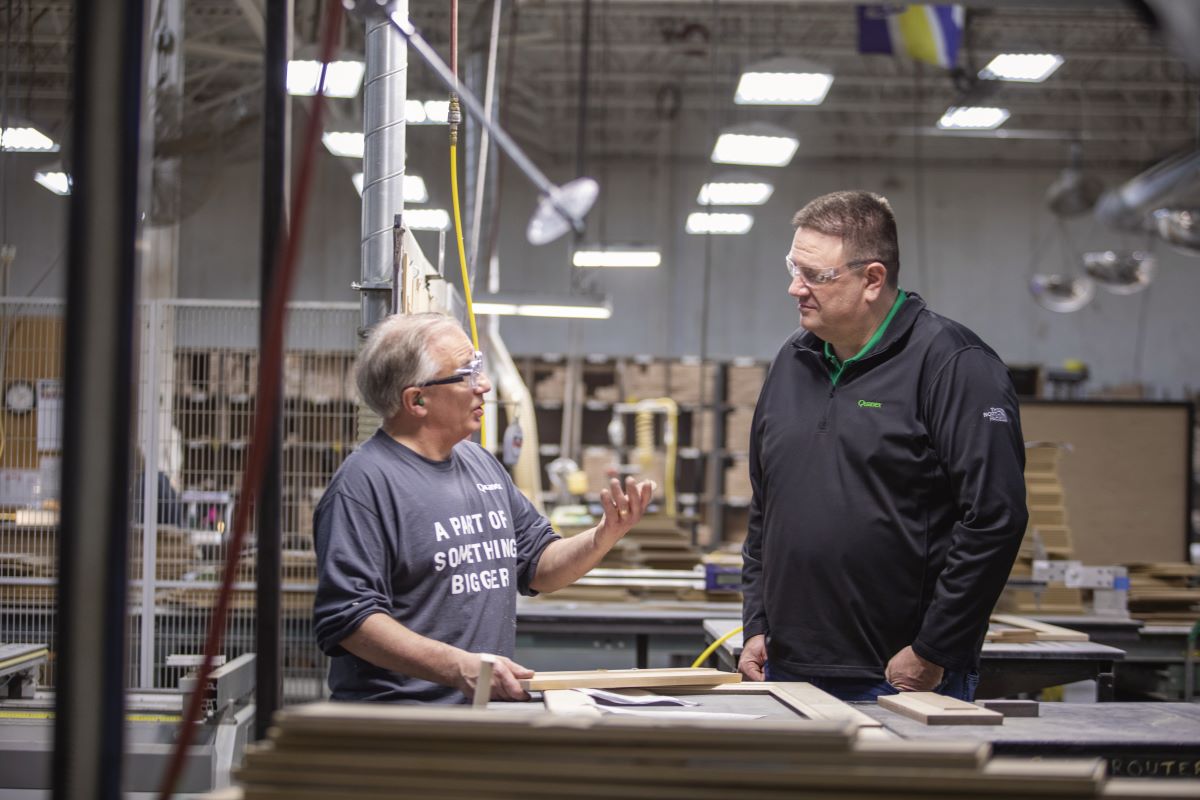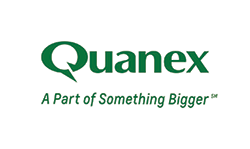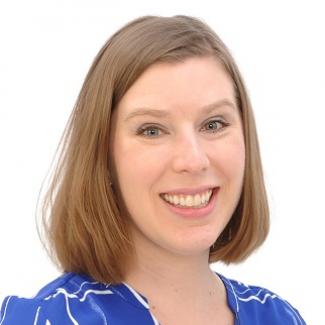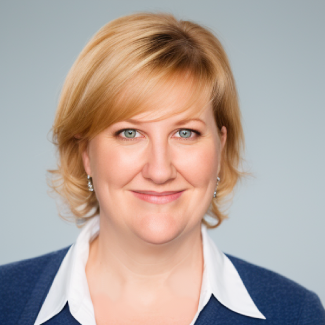Q + A | Inside the “New” Quanex
From manufacturing leader to versatile global supplier, how Quanex is evolving with expanded capabilities, strategic acquisitions and a customer-first outlook to drive the future of fenestration

Above: From left, Craig Gorecki and George Wilson at the Quanex Custom Solutions plant in St. Cloud, Minnesota. Photo courtesy of Quanex.
 After it’s rebranding in 2022, Window + Door sat down with Quanex President and CEO George Wilson to discuss its rebranding, its focus on people and its goals going forward. Three years later, Quanex is evolving from a manufacturing leader in fenestration to a versatile global supplier by expanding capabilities through strategic acquisitions, enhancing customer focus, investing in R&D for innovative, energy-efficient products, and broadening its market reach to drive growth and adapt to industry challenges. We visited with Wilson again to discuss the company’s reshaped brand identity, market focus, growth strategies and vision for the future of fenestration amid industry challenges.
After it’s rebranding in 2022, Window + Door sat down with Quanex President and CEO George Wilson to discuss its rebranding, its focus on people and its goals going forward. Three years later, Quanex is evolving from a manufacturing leader in fenestration to a versatile global supplier by expanding capabilities through strategic acquisitions, enhancing customer focus, investing in R&D for innovative, energy-efficient products, and broadening its market reach to drive growth and adapt to industry challenges. We visited with Wilson again to discuss the company’s reshaped brand identity, market focus, growth strategies and vision for the future of fenestration amid industry challenges.
Window + Door: When we talked two years ago, Quanex had rebranded from Quanex Building Products to Quanex with the goal of building Quanex as a manufacturing company rather than a window and door company. How has rebranding impacted your brand identity with customers?
George Wilson: The rebranding was necessary on multiple fronts. It has been important for us and has significantly shaped our brand identity with our customers, shareholders and the communities that we operate in. Initially, we were perceived as a collection of small independent companies, which didn’t truly reflect our unified capabilities as a singular manufacturing leader. The shift to the “One Quanex” approach was essential in communicating the depth of our operational and product design capabilities, showing our customers that we are much more than just components like spacers or screens. That scale is important. We’re starting to create systems and do different things. This rebranding has allowed us to highlight our global geographic footprint and capabilities, which in turn, offers potential logistics, cost savings and tariff mitigation for our customers. Providing a product that’s manufactured in the country in which it’s needed has enormous value for our customers. By highlighting our extensive range of products and services beyond just window and door solutions, we’ve made it clear that we are a versatile component supplier to many different Industries, including solar, automotive and medical, thereby enhancing our perceived value in the market.
The rebranding has also fostered a stronger internal culture and engagement amongst employees, promoting a shared vision that nurtures best practices across divisions. It highlights greater opportunities, allowing employees to envision different career opportunities within various divisions. This approach not only benefits employees by enhancing job satisfaction and competitiveness in wages and benefits, but also resonates with an industry that is starting to see us as a comprehensive component supplier, rather than operating in the fenestration sector. While we’re still on a journey to fully realize this vision, the progress we’ve made has been substantial, and I’m very happy with the enormous progress that we’ve made and I’m proud of the team for what they’ve done in redefining our identity.
WD: Are you targeting opportunities in new markets based on your expanded core competencies?
GW: Expansion into other markets is a high priority for Quanex. When you look at the window and door market, we effectively do everything but the glass—we have no desire to manufacture glass and we’re never going to be a glass supplier—but we can pretty much do everything else. Continued growth in adjacent markets utilizing our capabilities is key for us to continue to grow. In addition to adjacent markets, we are also exploring new materials and material sciences to allow for expansion that is both organic and through acquisition over the next five years.
WD: With your focus on external growth (e.g., your acquisition of AmesburyTruth), where else have you grown and where do you plan to continue growing?
GW: I’m excited about the opportunities to continue to expand our extruded solutions segment in both the UK and international markets. Our global footprint is important, and I think you’ll see continued expansion in other areas of the world. Additionally, our seals and spacer products have enormous potential. With the acquisition of the Schlegel product line—comprising weather seals, gaskets and various pile seals—we can now integrate these with our Quanex spacer products, leading to further global growth.
Other key areas include our Bilco access product lines—focusing on roof and basement access products—which operate in an underserved market that remains ripe for expansion, and we plan to invest significantly in growing this product line. Similarly, since acquiring Quanex Custom Mixing nearly three years ago, I’m optimistic about its growth potential and we will continue to allocate resources to expand this segment. While our focus is on gaskets, spacers, mixing and access, we are not ignoring the hardware business, where we are already a significant player. I am excited about the possibilities for expansion across all these areas, particularly in European markets.
WD: How does Quanex ensure that it stays attuned to customer needs as you focus on growth?
GW: The core of our business must support future growth; we can’t take our eye off it. We’ve expanded all the customer-facing areas of the organization—increasing the sales team, product management, customer service, engineering and quality—so this wasn’t just an acquisition to realize cost synergies; it was about fueling growth, a very different opportunity. We often talk about synergies, but everyone immediately thinks of cost-cutting and this was far from that, and I wouldn’t have pursued this deal solely for cost reduction. My focus has been on enhancing those areas that interact with customers, positioning ourselves more as a growth story rather than just a model of manufacturing excellence. Of course, with that shift comes a certain level of pressure, and it’s crucial to listen to our customers as we move forward.
We aim to continue along this path, emphasizing the importance of understanding what our customers need and want, obsessing over the ways to exceed those expectations, which is a core part of our vision statement. This principle drives everything we do. Do we always get it right? I admit that we don’t, but since the acquisition, I’ve been so pleased to witness the passion and excitement within the team. They genuinely want to turn our vision into reality. By investing in customer-facing areas and bringing in the right people who are dedicated to meeting customer needs and building solid relationships, I believe we are taking significant steps toward creating something new and special.
WD: You previously mentioned significant investment in R&D. Could you elaborate on the types of products you are focusing on developing?
GW: There are a lot of exciting things happening right now. With the acquisition of Tyman and our increased focus and investment in product management and R&D, we are more efficient in where we’re putting our money. My current focus is on products that improve the thermal performance of houses, including new materials, innovations and processes to enhance windows and doors. We’re also exploring home security solutions, such as security screens. Given the importance of security today, we see tremendous value in creating products that allow people to keep their windows open while ensuring safety for their families. Another major focus is on improving water and air tightness to help families from a health, safety, cost and energy efficiency perspective. These areas are the key priorities we’re focusing on across product lines.
This industry focus aligns with changing codes and standards in the country, driven by a new generation of consumers who care about environmental sustainability but also seek financial payback. Energy costs will not get as low as we would like, so it’s crucial to improve product efficiency. For example, when I moved to Texas, I was surprised by how many single-pane windows were still in use despite high air conditioning demands all year-round. You can’t ignore energy use, and stricter codes and standards will increasingly shape the industry in a bid to be more efficient. Our products already meet most of these standards, because of our presence in Europe, which is about 10 years ahead of the U.S. in passive housing and zero-energy standards. While we’re proud of where we stand, we’re not complacent—we will continue to push the envelope and innovate for future generations, and that’s where our R&D spending will remain focused.
WD: The industry is in a challenging time right now with tariffs, housing affordability, an uncertain economy and more. How is this impacting Quanex and what actions are you taking in anticipation?
GW: Quanex is focused on controlling what we can control and being ready to adapt fast. We’re creating an operating system that allows us to react quickly to fast changes in demand and simplify complexity for our customers. There’s a lot of noise out there—whether it’s tariffs, interest rates or negative consumer confidence—but we can’t control those external factors. What we can do is react faster than anyone else, and that’s been our central focus.
We’re now in the midst of restructuring our business as we continue to integrate the Tyman acquisition, and as part of that effort, we have created three new segments called Quanex Extruded Solutions, Quanex Hardware Solutions and Quanex Custom Solutions. With the help of technology, these manufacturing capability focused segments will enable us to react quickly to challenges. The world is global and interconnected, so responsiveness is key.
WD: Looking ahead, how do you envision the broader fenestration industry evolving in the next few years, and how will Quanex fit into that picture? Are there key milestones you hope to achieve in terms of product innovation and market expansion?
GW: For the fenestration industry, it’s going to be interesting because I think that there will continue to be a lot of changes. From a macro perspective, I think we’re going to see some short-term noise around tariffs, interest rates and housing affordability. For the total market, I think you’ll continue to see consolidation. It’s hard to be a small company; regulation will start to tighten and scale is important, so I think you’ll see some of the larger customers get bigger. We started to see some of that, although it slowed down over the last year because of market uncertainty. However, overall, I think that trend will continue. I also expect challenging labor markets and ongoing supply chain complexity. Another key impact on fenestration is the continued pressure for codes and standards to increase, which will increase the bar for product performance throughout the industry.
Through consolidation, we are a big tier-one supplier. Our product and capability portfolio is broad, with a global footprint, which helps our customers in a challenging world because being a big company adds stability and safety in who you’re buying from. It gives us the scale to be efficient and effective and allows us to take complexity away from our customers so they can focus on building the window and reaching their end markets. The next five to 10 years is going to be a rapidly changing environment for the fenestration industry. What we’ve tried to do here at Quanex is anticipate that and I’m excited about our company’s future.

